Establishing good bass drum foot technique is very important in the early stages of drumming. The better your technique is, the easier it will be to learn and master new patterns.
Good technique will also help you to play for longer periods, and prevent you from getting injured.
In this guide, I’ll show you how to play bass drum notes in a few different ways. Each bass drum technique has unique benefits. Some drummers use all of them, while others only stick to a few.
I’ll also give you a few exercises to try out that will help you work on these techniques.
Contents
Posture and Positioning
Before getting into the nitty gritty, it’s important to note that proper kick drum technique starts with how you’re seated at the drums. You can sit in a few different positions, but most beginners should follow these guidelines so that they start as comfortably as possible.
Firstly, you should raise your drum throne high enough so that your thigh has a slight downward angle.
If your drum throne is too low and your thigh is flat or angled upward, you’ll be putting a lot of strain on your leg muscles.
By having a downward thigh angle, you’ll be using gravity to help you play bass drum notes. This will put a lot less strain on your leg, and it will allow you to play for longer.
You should then place your drum throne far enough away so that your legs feel comfortable on the pedals, but you mustn’t be so far that you need to stretch your arms to reach the drums.
Once you have your positioning right, you can focus on how you use your foot on the kick pedal.
Bass Drum Pedal Technique
Heel-Down
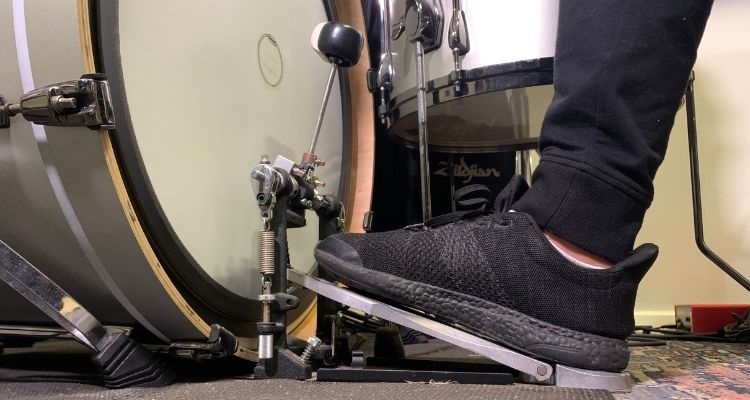
The heel-down technique is when you keep your whole foot flat on the bass drum pedal. For this technique, you’ll be lifting the top part of your foot to play the pedal while your heel stays flat on the pedal.
This tends to be what most beginners start with, as it’s a bit easier to get the hang of. If you use this technique, make sure that your drum throne isn’t raised too high.
The benefits of heel-down are that you can play softer strokes a lot easier. That’s why this is the go-to option for jazz drummers that want soft bass drum notes.
Some drummers feel that they have more control when using it, but it mostly depends on the drummer and what they’re most comfortable with.
When using heel-down, you’ll mostly be utilizing your shin muscles to play bass drum strokes.
Heel-Up
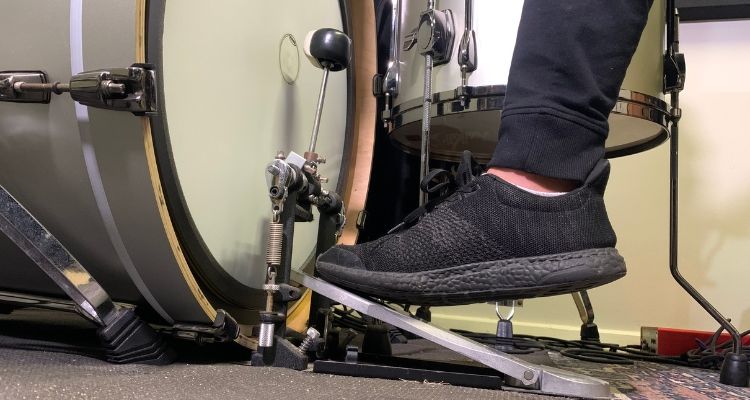
Heel-up refers to when you keep the upper part of your foot and toes on the pedal while the rest of your foot is raised in the air.
When using this technique, you get a good balance of speed, volume, and overall power. You can put more force behind your strokes, as you’ll be using your upper leg muscles. That leads to far louder bass drum notes compared to when you play with your heel down.
With this technique, you have to choose where to place your toes on the pedal, as there’ll be a lot more open room compared to heel-down.
If you place your toes near the bottom, you’ll get more speed. If you place them near the top, you’ll get more power, as it’ll allow you to put more force behind your strokes.
Make sure that your drum throne is raised quite high when using this technique, as it will make it easier to keep your foot in the air.
Burying Your Beater
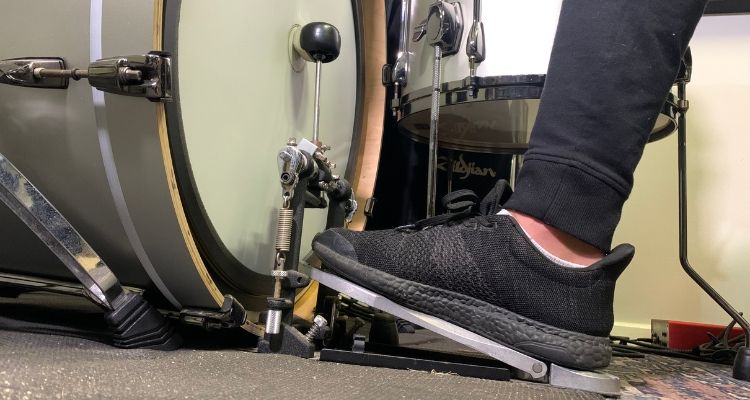
With both bass drum techniques, you have to choose whether to keep your beater buried after strokes or lift it up.
When you bury the beater, it means that you’re keeping it tight on the bass drum head after hitting the center.
A lot of old-school drummers claim that this is bad technique. However, it has its place, and I wouldn’t say that it’s wrong.
When you bury the beater, it chokes out the resonance of the bass drum. It stops the drumhead from fully vibrating, and that leads to a shorter sound.
The result of this is a lot worse if you don’t have any muffling inside the bass drum shell. With no muffling, your bass drum should resonate a lot, and choking out that resonance will sound weird. It also feels weird when you’re playing.
If you have blankets or pillows inside the kick drum, burying your beater won’t make much of a difference to the sound, and that’s why I say it’s not so bad. You may just prefer how it feels.
Lifting Your Beater
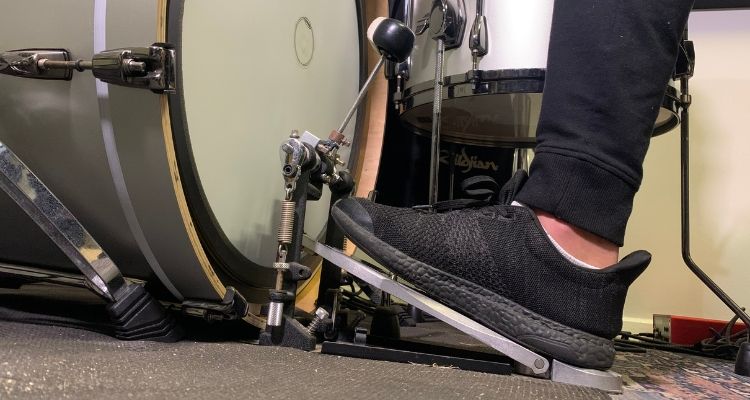
Lifting your beater is the traditional technique for playing bass drum notes. Every time you strike the bass drum, you need to release the pressure of your foot from the pedal to ensure that the beater goes back to its original spot.
When you do this, the bass drum will resonate as much as it’s designed to.
Lifting our beater is a lot easier to do when using a heel-down stance. It naturally lifts, as you’re less likely to keep your foot pressed down on the pedal.
It’s a lot harder to lift the beater when playing heel-up. Gravity makes you want to keep your toes firmly planted on the pedal, and it feels better to just keep the beater pressed into the drumhead.
Bass Drum Speed Techniques
The following two techniques will allow you to play quick consecutive double strokes on the bass drum. Both of them are commonly used, with most drummers preferring one over the other.
Heel Toe Techniques

The heel-toe technique is when you play a bass drum stroke using the whole weight of your foot first, and then you play a second stroke with your toe.
This technique works a lot easier if you regularly play with your heel down, as your foot will be in the starting position at all times, making it feel natural.
To really pull it off, you need to ensure that you’re using the entire weight of your foot for the first stroke. Think about transferring the energy from your whole foot to the top part of your foot.
You also need to switch to playing the second toe stroke as soon as you feel the upward rebound from the pedalboard.
Slide Techniques
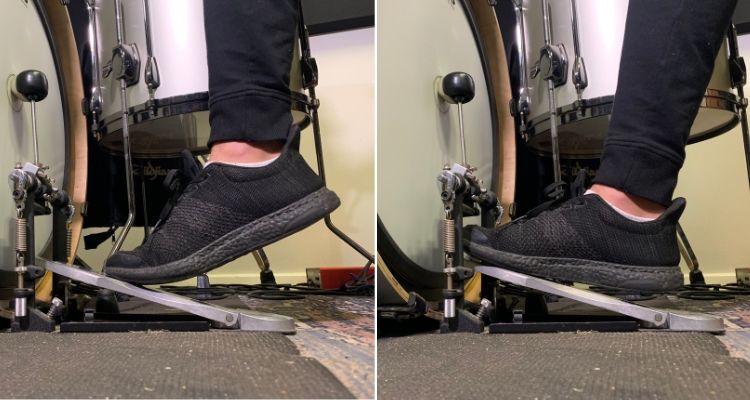
The slide technique is arguably a better option for drummers that play with their heels up. For this technique, you’re going to place your toes in the center of the pedalboard. When you press down, you’ll feel the resistance of the pedal pushing upward.
Once you feel that, you’re going to slide your toes forward to the top of the pedalboard and press down while doing that. That motion will give you the second stroke.
This technique doesn’t give you as much control as the heel-toe one, but it’s far easier to learn and master.
Some drummers like to move the back of their ankles outward as they slide down to the second movement.
Exercises to Work On Kick Drum Technique
Exercise 1

This is called a four-on-the-floor drum groove. For this exercise, you just need to focus on how you’re playing the bass drum notes. Try it with both heel-up and heel-down techniques and see which one feels better for you.
Exercise 2

This next groove has you playing bass drum notes on all the offbeats in the bar. It may be a bit tricky at first, but the goal is to play them as cleanly as possible. Remember to start slow.
If you play heel-down, it will work your shin muscles. If you play heel-up, it will work your thigh muscles.
Exercise 3

This exercise is a basic way of applying the slide or heel-toe techniques. The faster you play it, the more you’ll need to incorporate one of those techniques to allow your beater to play the two consecutive notes.
Exercise 4

This groove is similar to the last one, but you’ll be playing the two bass drum notes as 32nd notes instead of 16th note triplets. This means you need to play them a bit quicker.
Exercise 5

This final exercise is a big challenge for your bass drum foot. You need to make sure that you’ve grasped the fundamentals of the slide or heel-toe techniques. You can then use this exercise to strengthen how well you play them.
The aim is to play this groove as fast as you can without your foot getting tired.
Conclusion
The biggest key to perfecting your bass drum technique is practice. The more you focus on what you’re doing and how you’re doing the movements, the better you’ll get. Drumming is all about muscle memory development, and your body will eventually go into autopilot once you’ve used these techniques enough.
Choose whether you want to play with your heel up or down, and then run through all the exercises that I showed you a few times daily. When you do that, you’ll be playing blazing fast foot patterns in no time.
If you want to play double bass drum patterns, you can utilize the same techniques. Double bass drumming just requires you to have equally good technique with both double bass pedals.









